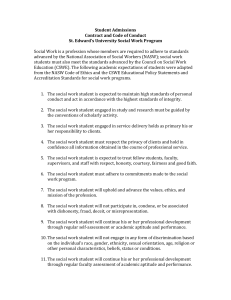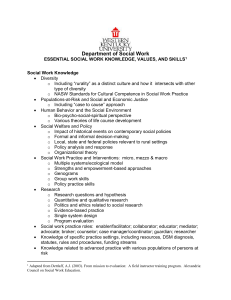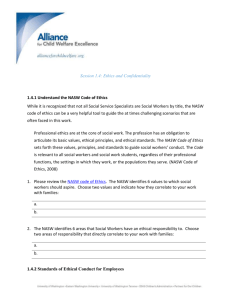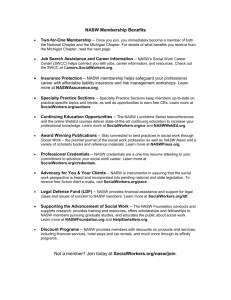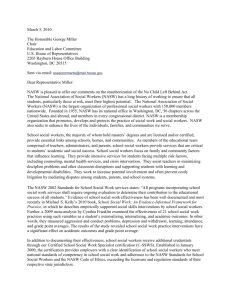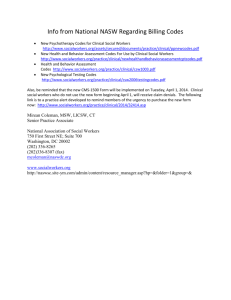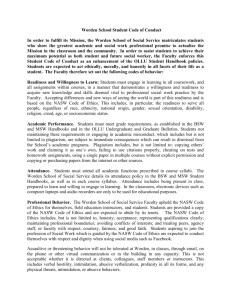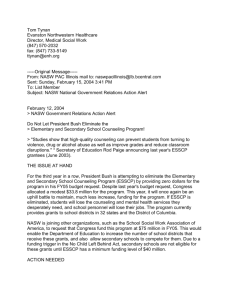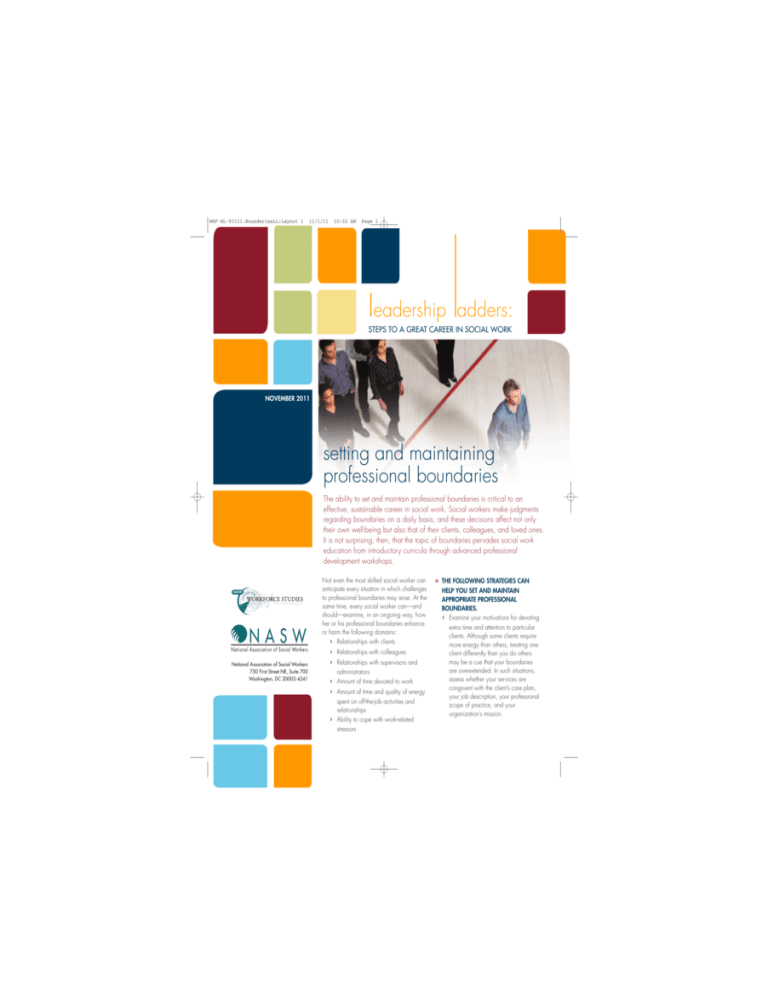
WKF-NL-93111.BounderiesLL:Layout 1
11/1/11
10:32 AM
Page 1
leadership
adders:
STEPS TO A GREAT CAREER IN SOCIAL WORK
NOVEMBER 2011
setting and maintaining
professional boundaries
The ability to set and maintain professional boundaries is critical to an
effective, sustainable career in social work. Social workers make judgments
regarding boundaries on a daily basis, and these decisions affect not only
their own well-being but also that of their clients, colleagues, and loved ones.
It is not surprising, then, that the topic of boundaries pervades social work
education from introductory curricula through advanced professional
development workshops.
NASW
National Association of Social Workers
750 First Street NE, Suite 700
Washington, DC 20002-4241
Not even the most skilled social worker can
anticipate every situation in which challenges
to professional boundaries may arise. At the
same time, every social worker can—and
should—examine, in an ongoing way, how
her or his professional boundaries enhance
or harm the following domains:
› Relationships with clients
›
›
›
›
›
Relationships with colleagues
Relationships with supervisors and
administrators
Amount of time devoted to work
Amount of time and quality of energy
spent on off-the-job activities and
relationships
Ability to cope with work-related
stressors
»
THE FOLLOWING STRATEGIES CAN
HELP YOU SET AND MAINTAIN
APPROPRIATE PROFESSIONAL
BOUNDARIES.
› Examine your motivations for devoting
extra time and attention to particular
clients. Although some clients require
more energy than others, treating one
client differently than you do others
may be a cue that your boundaries
are overextended. In such situations,
assess whether your services are
congruent with the client’s care plan,
your job description, your professional
scope of practice, and your
organization’s mission.
WKF-NL-93111.BounderiesLL:Layout 1
11/1/11
›
›
Recognize
that exceeding
your
professional
boundaries
with clients
sets up your
colleagues and
organization
for failure.
›
›
10:32 AM
Page 2
Apply, on a consistent basis, your
organization’s processes for
communicating with clients. Such
communication systems can include
office email or voicemail, dedicated
cell phones or pagers, receptionists or
call centers, on-call staff, and off-hours
referrals to 911, emergency rooms, or
community mental health crisis centers.
You may think you’re helping clients by
deviating from existing procedures—
for example, by encouraging them to
contact you directly in a crisis, rather
than going through appropriate
channels. At some point, however, you
will be unable to respond to a client in
need. When that happens, the client
may lose trust in you or be reluctant to
seek help in other ways.
Recognize that exceeding your
professional boundaries with clients
sets up your colleagues and
organization for failure. Going beyond
the parameters of your service system
or role creates an unfair expectation
that your coworkers do the same.
Inconsistent professional boundaries
within teams and organizations may
confuse clients and erode their
confidence in your organization.
Be discriminate in your use of social
media. Avoid “friending” clients on
Facebook, for example, and limit the
amount and type of online information
you make available to the public—or
even to your friends’ social networks—
to prevent conflicts of interest with
clients (Hobdy, 2011). Similarly, don’t
attempt to access, without informed
consent, online information about your
clients (Hobdy, 2011). Realize, too,
that posting negative information
about your workplace may
demonstrate a lack of respect for
colleagues and violate the NASW
Code of Ethics (2008) (Reamer,
2009).
Develop strong working relationships
with your colleagues. Although your
coworkers need not be your friends,
friendly workplace alliances can be
invaluable in coping with the stresses
of social work practice and maintaining
your sense of humor. Moreover, trusted
colleagues can help you think through
boundary-related questions.
›
›
Use supervision and consultation to
help you determine appropriate
professional boundaries in challenging
situations. Maintain an ongoing
dialogue with your supervisor about
your workload. Use tangible tools,
such as assessment forms and NASW
standards of practice, to communicate
your clients’ needs and the ways in
which you spend your time on the job.
If systems to address client needs do
not exist within your organization—or
if clients repeatedly experience
difficulty in accessing services—
collaborate with your supervisor or
administrator to address the problem,
rather than trying to fill those gaps
singlehandedly.
›
Be attuned to signs of workplace
bullying (Whitaker, 2010). You
deserve the same respect and dignity
in your work environment that you offer
to your clients and colleagues.
›
Find ways to nurture yourself
throughout your workday and during
your commute. Take regular lunch
breaks—if possible, away from your
desk, outside your car, or otherwise
apart from work responsibilities. Find
ways to change pace occasionally
during the day: stand and stretch
occasionally if you sit at a desk; listen
to music, an audio book, or an
enjoyable radio program while driving
to client visits or during your commute;
take a brief walk; or simply breathe
deeply and consciously for a minute.
›
Take time away from your job to
rejuvenate. Strive to maintain a regular
work schedule and avoid working
overtime on a routine basis.
Determine—if appropriate, in
collaboration with your supervisor—
how much, if at all, you need to be
available off the job, be it overnight,
when you’re ill, or during vacations.
Clear expectations are especially
important if you use a “smart phone”
or other technology to access work
email remotely. Don’t confuse
professional responsiveness and
responsibility with being accessible to
your colleagues (let alone your clients)
24 hours a day, seven days a week.
›
›
›
Devote time off the job to activities that
nurture you. Spending time with family
or friends, reading, watching a movie,
singing, journaling, meditating,
exercising, or other diversions can
re-energize you to return to work.
Allow time for rest, too.
Be attuned to the ways in which you
absorb work stresses and take steps to
manage that stress. Even social
workers with excellent external
boundaries (such as a regular work
schedule), supportive colleagues, and
manageable caseloads often find
themselves “taking work home” on an
emotional level. This can result in
persistent worry about client situations
while away from the job or unfounded
fears of professional inadequacy.
Work-related stress can also result in
hypervigilance within a social worker’s
personal life—for example, fearing the
onset of illness, despite the absence of
symptoms, because of constant
exposure to client illness. Writing
about your feelings or talking with
someone you trust can help you
process the impact of work on your life
and maintain clear internal boundaries
between your professional and
personal lives.
If you find yourself struggling
consistently to maintain professional
boundaries, consider seeking support
from a licensed mental health
professional to understand your
behavior and evaluate the
sustainability of your current role or
work environment.
NASW RESOURCES
NASW Continuing Educatio
www.socialworkers.org/ce
Extensive listing of conferen
workshops, webinars, teleco
and distance learning oppo
»
»
NASW Lunchtime Series
www.socialworkers.org/ce
lunchtime
Multiple archived teleconfer
webinars (2007–2011) ad
topics such as the workplac
environment, social worker
managing competing dema
and risk management
»
NASW Professional Educa
Training Center
www.manexa.com/naswd
Multiple ethics courses, ava
NASW members and the p
»
NASW Specialty Practice S
www.socialworkers.org/se
Multiple archived webinars
teleconferences (2007–201
addressing topics such as p
grief, the ethics of social ne
management, and ethical d
making
»
NASW WebEd courses
www.naswwebed.org
Three online courses addres
and malpractice risk
»
Code of Ethics of the Natio
Association of Social Work
http://preview.socialwork
pubs/code
Available in English and Sp
»
Encyclopedia of Social Wo
20th ed. (2008)
www.naswpress.org/publ
reference/encyclopedia.ht
Includes articles addressing
conduct, professional impai
professional liability and ma
on a consistent basis, your
ation’s processes for
icating with clients. Such
ication systems can include
mail or voicemail, dedicated
nes or pagers, receptionists or
ers, on-call staff, and off-hours
to 911, emergency rooms, or
ity mental health crisis centers.
y think you’re helping clients by
g from existing procedures—
mple, by encouraging them to
you directly in a crisis, rather
ng through appropriate
s. At some point, however, you
nable to respond to a client in
When that happens, the client
e trust in you or be reluctant to
p in other ways.
ze that exceeding your
onal boundaries with clients
your colleagues and
ation for failure. Going beyond
meters of your service system
reates an unfair expectation
r coworkers do the same.
ent professional boundaries
ams and organizations may
clients and erode their
nce in your organization.
minate in your use of social
Avoid “friending” clients on
ok, for example, and limit the
and type of online information
ke available to the public—or
your friends’ social networks—
nt conflicts of interest with
Hobdy, 2011). Similarly, don’t
to access, without informed
online information about your
Hobdy, 2011). Realize, too,
ing negative information
our workplace may
rate a lack of respect for
es and violate the NASW
f Ethics (2008) (Reamer,
strong working relationships
r colleagues. Although your
ers need not be your friends,
workplace alliances can be
WKF-NL-93111.BounderiesLL:Layout 1
invaluable in coping with the stresses
of social work practice and maintaining
your sense of humor. Moreover, trusted
colleagues can help you think through
boundary-related questions.
›
›
Use supervision and consultation to
help you determine appropriate
professional boundaries in challenging
situations. Maintain an ongoing
dialogue with your supervisor about
your workload. Use tangible tools,
such as assessment forms and NASW
standards of practice, to communicate
your clients’ needs and the ways in
which you spend your time on the job.
If systems to address client needs do
not exist within your organization—or
if clients repeatedly experience
difficulty in accessing services—
collaborate with your supervisor or
administrator to address the problem,
rather than trying to fill those gaps
singlehandedly.
›
Be attuned to signs of workplace
bullying (Whitaker, 2010). You
deserve the same respect and dignity
in your work environment that you offer
to your clients and colleagues.
›
Find ways to nurture yourself
throughout your workday and during
your commute. Take regular lunch
breaks—if possible, away from your
desk, outside your car, or otherwise
apart from work responsibilities. Find
ways to change pace occasionally
during the day: stand and stretch
occasionally if you sit at a desk; listen
to music, an audio book, or an
enjoyable radio program while driving
to client visits or during your commute;
take a brief walk; or simply breathe
deeply and consciously for a minute.
›
Take time away from your job to
rejuvenate. Strive to maintain a regular
work schedule and avoid working
overtime on a routine basis.
Determine—if appropriate, in
collaboration with your supervisor—
how much, if at all, you need to be
11/1/11
10:32 AM
available off the job, be it overnight,
when you’re ill, or during vacations.
Clear expectations are especially
important if you use a “smart phone”
or other technology to access work
email remotely. Don’t confuse
professional responsiveness and
responsibility with being accessible to
your colleagues (let alone your clients)
24 hours a day, seven days a week.
›
›
›
Devote time off the job to activities that
nurture you. Spending time with family
or friends, reading, watching a movie,
singing, journaling, meditating,
exercising, or other diversions can
re-energize you to return to work.
Allow time for rest, too.
Be attuned to the ways in which you
absorb work stresses and take steps to
manage that stress. Even social
workers with excellent external
boundaries (such as a regular work
schedule), supportive colleagues, and
manageable caseloads often find
themselves “taking work home” on an
emotional level. This can result in
persistent worry about client situations
while away from the job or unfounded
fears of professional inadequacy.
Work-related stress can also result in
hypervigilance within a social worker’s
personal life—for example, fearing the
onset of illness, despite the absence of
symptoms, because of constant
exposure to client illness. Writing
about your feelings or talking with
someone you trust can help you
process the impact of work on your life
and maintain clear internal boundaries
between your professional and
personal lives.
If you find yourself struggling
consistently to maintain professional
boundaries, consider seeking support
from a licensed mental health
professional to understand your
behavior and evaluate the
sustainability of your current role or
work environment.
Page 3
NASW RESOURCES
NASW Continuing Educational Portal
www.socialworkers.org/ce/search.asp
Extensive listing of conferences,
workshops, webinars, teleconferences,
and distance learning opportunities
»
»
NASW Lunchtime Series
www.socialworkers.org/ce/online/
lunchtime
Multiple archived teleconferences and
webinars (2007–2011) addressing
topics such as the workplace
environment, social worker safety,
managing competing demands, ethics,
and risk management
»
NASW Professional Education and
Training Center
www.manexa.com/naswdc
Multiple ethics courses, available to both
NASW members and the public
»
NASW Specialty Practice Sections
www.socialworkers.org/sections
Multiple archived webinars and
teleconferences (2007–2011)
addressing topics such as professional
grief, the ethics of social networking, risk
management, and ethical decision
making
»
NASW WebEd courses
www.naswwebed.org
Three online courses addressing ethics
and malpractice risk
»
»
Code of Ethics of the National
Association of Social Workers (2008)
http://preview.socialworkers.org/
pubs/code
Available in English and Spanish
Encyclopedia of Social Work,
20th ed. (2008)
www.naswpress.org/publications/
reference/encyclopedia.html
Includes articles addressing professional
conduct, professional impairment, and
professional liability and malpractice
Using PowerPoint
Appropriate use of PowerPoint is critical for public presentations. Whil
e.g, its use of bulleted lists encourages complex ideas to be distilled int
it remains the standard visual aid for presentations. The following are t
from presentation experts (APHA, 2011; Toastmasters, 2011; Winebe
•
•
•
•
•
•
•
Make the text large–no slides with print less than 32-point type
Don’t read your slides to the audience. The only exception is a dire
Choose colors that make the text easy to read – use boldface type
Use phrases or bullet points, not full sentences
Avoid charts and diagrams that are hard to see
Each slide should present one subject or idea; busy slides are confu
Be mindful that your audience may include people with seeing, hea
(words, charts and diagrams) need to be described verbally. Descr
disabilities, they are also appreciated by people seated at a distan
WKF-NL-93111.BounderiesLL:Layout 1
11/1/11
10:32 AM
Page 4
»
NASW standards for social work
practice (various settings and populations)
www.socialworkers.org/practice
»
Social Work Speaks: National
Association of Social Workers Policy
Statements 2009–2012 (8th ed.)
www.naswpress.org/publications/
practice/speaks.html
Includes policy statements addressing
ethics, professional impairment, and
professional self-care
REFERENCES
Hobdy, D. (2011). Professional ethics and
social networking [NASW Specialty Practice
Sections webinar]. Retrieved from
www.socialworkers.org/sections/tele
conferences/tcourses/Default.aspx?course
ID=020e171a-1bc9-4e15-92e8-260fe24b
4c2f&header=OFF
National Association of Social Workers.
(2008). Code of ethics of the National
Association of Social Workers [Revised
edition]. Retrieved from
www.socialworkers.org/pubs/code
Reamer, F. G. (2009, November). Novel
boundary challenges: Social networking.
Social Work Today. Retrieved from
www.socialworktoday.com/news/
eoe_111309.shtml
If you find
yourself
struggling
consistently to
maintain
professional
boundaries,
consider
seeking
support from
a licensed
mental health
professional.
Whitaker, T. (2010). Healthy or hostile?
The importance of the workplace
environment [NASW Lunchtime Series
webinar]. Retrieved from
www.socialworkers.org/ce/online/
lunchtime/lcourses/home.aspx
©2011 National Association of Social Workers. All Rights Reserved.

